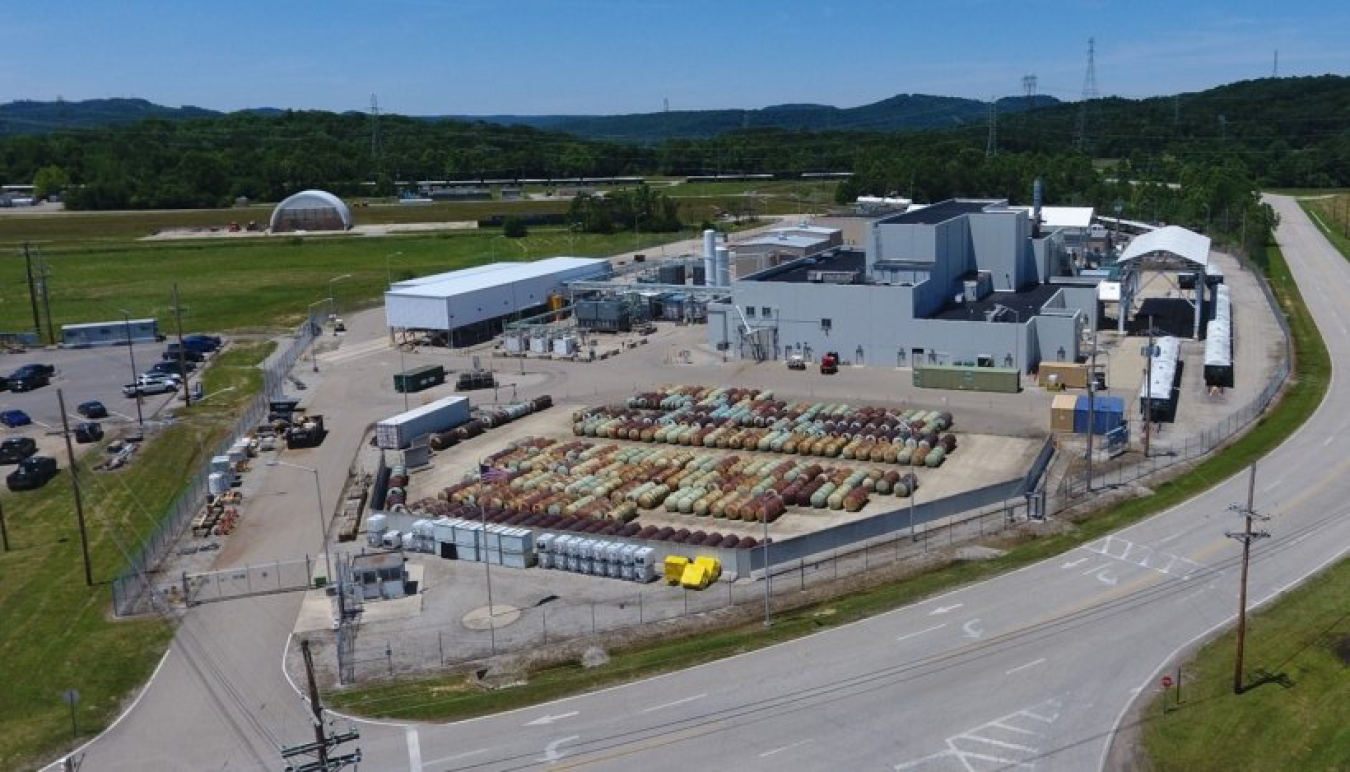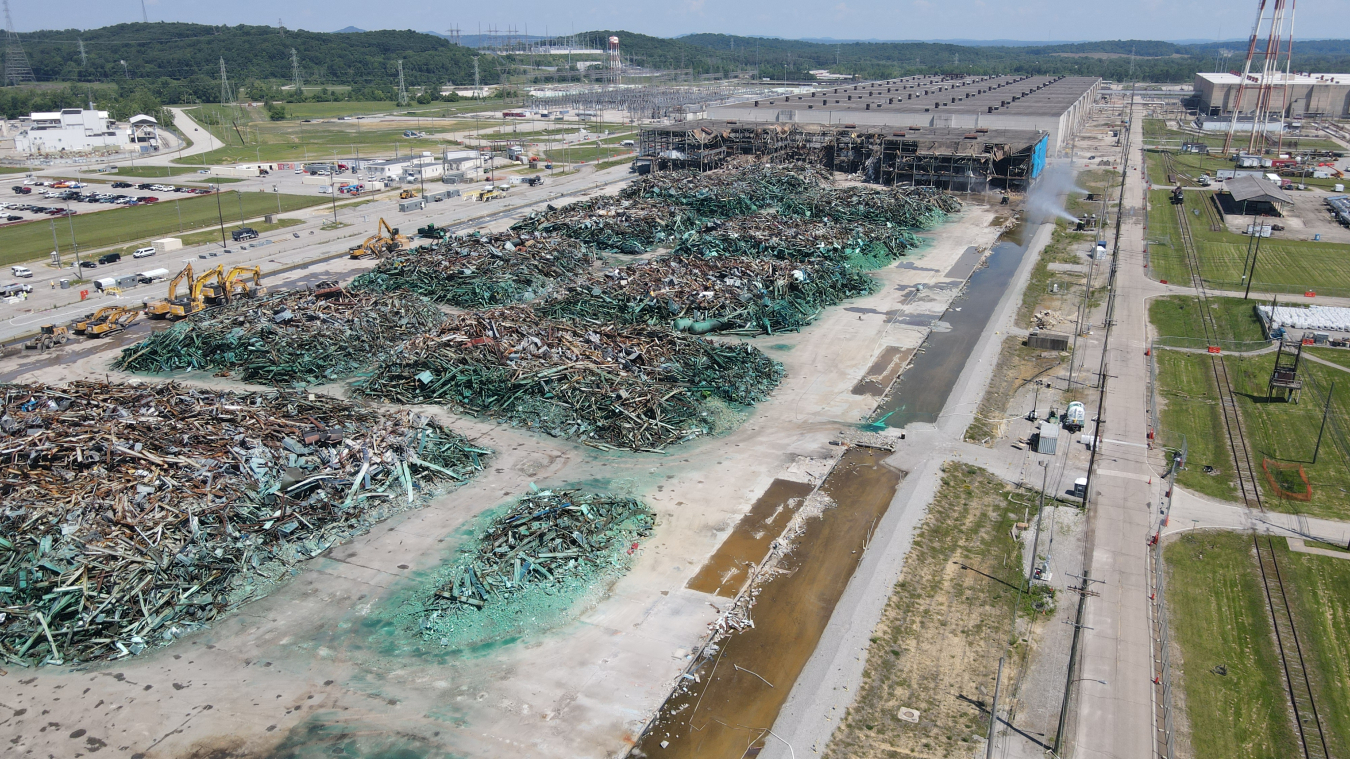Overview
In August 1952, the AEC selected a tract of land in the Ohio Valley along the Scioto River in Pike County, Ohio, for the site of the Portsmouth Gaseous Diffusion Uranium Enrichment Plant (GDP), the third of three GDPs in the United States. In 1956, construction of the plant was completed, and the plant began enriching uranium for nuclear weapons. In the 1960s, Portsmouth’s mission changed to focus on producing fuel for commercial nuclear power plants and other national security applications.
An extensive environmental cleanup program began at the 3,777-acre site in 1989, with deactivation and decommissioning activities initiated in 2011. The DOE’s near-term focus is the deactivation and decommissioning of 415 facilities, including the three former uranium enrichment process buildings (X-326, X-333, and X-330), each measuring over 50 acres of floor area. The site also continues to maintain utility operations, monitor air and water emissions, and operate several groundwater treatment facilities to address legacy groundwater contamination caused by former plant operations.
The Portsmouth Site is also home to one of DOE’s two depleted uranium hexafluoride (DUF6) conversion plants. DUF6 was a byproduct from uranium enrichment operations at Oak Ridge, Tennessee; Portsmouth, Ohio; and Paducah, Kentucky. DOE is safely converting the DUF6 material from approximately 67,000 steel cylinders at the Portsmouth and Paducah sites to more stable and usable compounds. At Portsmouth, the DUF6 conversion facility began operation in 2010.
Calendar Year 2022 Accomplishments
- Completed structural demolition of X-326 Process Building - meeting an EM 2022 priority.
- Completed excavation of X-231B landfill for use at the On-site Waste Disposal Facility
- Completed construction of three cells (1,4 and 5) for the On-Site Waste Disposal Facility
Key Regulatory Milestones 2023–2033
- None

Planned Cleanup Scope 2023–2033
Over the next decade, DOE plans to make significant progress in addressing the three former uranium enrichment process buildings at the site, with demolition of two to be completed in that time frame.
In 2023, deactivation work will continue on the second process building to be addressed, Building X-333. This will include size reduction and disposal of large components from the building. X-333 is scheduled to be demolished by 2031. Also, by 2031, DOE expects to complete deactivation of the third and final process building, Building X-330.
The first of an additional three new cells at the On-site Waste Disposal Facility (OSWDF) will be ready to accept waste in the 2025 timeframe to support demolition of the X-333 Process Building. The 5th and 6th cells of the OSWDF will begin accepting X-333 Process Building waste in the 2026 timeframe. Based on capacity needs to support the demolition of X-330 and other remaining site facilities, four-to-six additional OSWDF cells will be constructed. Additionally, over the next decade, two landfills and an additional plume will be excavated and disposed at the OSWDF..
In 2023, the Portsmouth DUF6 conversion facility expects to convert more than 2,000 metric tons of DUF6. DOE will also complete shipments of railcars and continue progress on infrastructure upgrades supporting uranium oxide disposal. By the end of 2033, approximately 56,000 metric tons of DUF6 will be converted and approximately 8.5 million gallons of hydrogen fluoride will be shipped off site for commercial use.

Post-2033 Cleanup Scope
Beyond 2033, the last three OSWDF cells are expected to be constructed to support the demolition of the X-330 Process Building and remaining balance of plant facilities. In addition, a Resource Conservation and Recovery Act (RCRA) decision will be made regarding final soil remediation. Cleanup activities are anticipated to be completed in the 2039-2043 timeframe, including the disposition of DUF6 located at Portsmouth.
As cleanup reaches its end state at Portsmouth, DOE will continue to transfer land for economic development. Through a grant with Ohio University, a multi-faceted community outreach program was completed to understand the community’s future use vision for the Portsmouth site, which led to community interest in an industrial style future use of the site. With the assistance of the PORTS Future Project and interaction with the Southern Ohio Diversification Initiative, the Portsmouth Site Specific Advisory Board, elected officials, economic development professionals, and others, the community has expressed a consensus vision to reindustrialize appropriate portions of the Portsmouth Site property.

